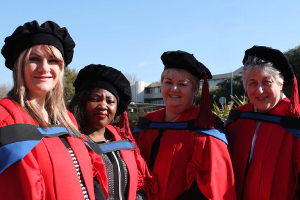
Dr Gloria Seiphetlheng, Dr Natasha Cronje, Dr Ismari van der Merwe and Prof Hester Steyn.
Photo: Leonie Bolleurs |
For the first time in its history, the Department of Consumer Science in the Faculty of Natural and Agricultural Sciences at the University of the Free State (UFS) earned three doctorates at one graduation ceremony this year. This week three PhDs were awarded to Ismari van der Merwe, Natasha Cronje, and Gloria Seiphetlheng at the Winter Graduation that took place on the Bloemfontein Campus.
Electrochemically-activated water is widely used in the food and other industries, due to its excellent environment-friendly properties. However, it is not used in the textile industry yet, because too little research has been done to determine the possible positive and negative impact it may have on textiles.
With the thesis, The evaluation of catholyte treatment on the colour and tensile properties of dyed cotton, polyester and polyamide 6,6 fabrics, Dr Cronje, a lecturer in the UFS’s Department of Consumer Science, and Dr Seiphetlheng from the Serowe College of Education in Botswana, provided major new information with the thesis, Anolyte as an alternative bleach for cotton fabrics. This information is essential when considering the application of catholytes and anolytes in the textile industry.
Electrochemically-activated water divides water in catholytes and anolytes. The anolyte part is used as a disinfectant and bleach. It is not really suitable for domestic use, as it can cause colour loss in coloured textile products. However, it can be used in the hospitality industry where white sheets, towels, etc., are used and washed on a regular basis.
The catholyte part of the water has properties similar to washing powder. It can also be used in the textile industry as washing liquid.
According to Prof Hester Steyn, Head of the Department of Consumer Science and supervisor of all three PhD candidates, this electrochemically-activated water is also very eco-friendly. “It has a short shelf life. If the electrochemically-activated water isn’t utilised, it returns to normal water that wouldn’t harm the environment. No water is therefore lost, and no waste products are released that would contaminate the environment,” she says.
Dr Van der Merwe’s research focused on Degumming Gonometa postica cocoons using environmentally conscious methods. A lecturer in the Department of Consumer Science, she demonstrated that simple and environmentally-friendly methods can be used with great success to procure wild silk from the cocoons of the Gonometa postica worms living in the camel thorn trees found in the Northern Cape and Namibia.